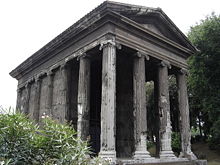Forum Boarium
 The Temple of Hercules Victor today. | |
 Click on the map for a fullscreen view | |
| Coordinates | 41°53′20″N 12°28′52″E / 41.88889°N 12.48111°E |
|---|---|
The Forum Boarium (Latin pronunciation: [ˈfɔɾʊ̃ˑ boˈäːɾiʊm], Italian: Foro Boario) was the cattle forum venalium of ancient Rome. It was located on a level piece of land near the Tiber between the Capitoline, the Palatine and Aventine hills. As the site of the original docks of Rome (Portus Tiberinus), the Forum Boarium experienced intense commercial activity.
The Forum Boarium was the site of the first gladiatorial contest at Rome which took place in 264 BC as part of aristocratic funerary ritual—a munus or funeral gift for the dead. Marcus and Decimus Junius Brutus Scaeva put on a gladiatorial combat in honor of their deceased father with three pairs of gladiators.
The site was also a religious centre housing the Temple of Hercules Victor, the Temple of Portunus (Temple of Fortuna Virilis), and the massive 6th or 5th century BC Great Altar of Hercules.
Architecture

The Temple of Hercules Victor or Hercules Olivarius (Hercules the Olive Branch Bearear[1] ), is a circular peristyle building dating from the 2nd century BC. It consists of a colonnade of Corinthian columns arranged in a concentric ring around the cylindrical cella, resting on a tuff foundation. These elements originally supported an architrave and roof which have disappeared. It is the earliest surviving marble building in Rome. For centuries, this was known as the Temple of Vesta.
The Temple of Portunus is a rectangular building built between 100 and 80 BC. It consists of a tetrastyle portico and cella mounted on a podium reached by a flight of steps. The four Ionic columns of the portico are free-standing, while the six columns on the long sides and four columns at the rear are engaged along the walls of the cella. It is built of tuff and travertine with a stucco surface. This temple was for centuries known as the Temple of Fortuna Virilis.
Sources claim the Forum was the site for placement of a statue by the sculptor Myron, which had been looted from Aegina. While the source mentions a cow, it may have been a statuary group of Theusus defeating the Minotaur, which was apt for a cattle market.[2]
On the late period of the Western Roman Empire, the area became overtaken with shops. Both temples were deconsecrated and converted to Christian churches.
Across the street is the church of Santa Maria in Cosmedin, housing the Bocca della Verità.
Restoration

Beginning in the late 1990s, a partnership between the Soprintendenza speciale per i beni archeologici di Roma and World Monuments Fund resulted in the conservation of both temples in the Forum Boarium. The project also included new landscaping for the site.[3] However, the Arch of Janus is still unrestored.
References
- ^ Barton Sholod, "Charlemagne in Spain. The Cultural Legacy of Roncesvalles", p. 144
- ^ New Guide of Rome, Naples and Their Environs, by Mariano Vasi, Antonio Nibby, page 115.
- ^ "Forum Boarium Guide". Retrieved 23 February 2016.
External links
- Lacus Curtius: Forum Boarium
- Virtual Tour and Pictures of Boarium Forum
- Forum Boarum, World Monuments Fund
- Lucentini, M. (31 December 2012). The Rome Guide: Step by Step through History's Greatest City. ISBN 9781623710088.Sequence
![]() Media related to Forum Boarium at Wikimedia Commons
Media related to Forum Boarium at Wikimedia Commons
| Preceded by Trajan's Forum |
Landmarks of Rome Forum Boarium |
Succeeded by Forum Holitorium |


